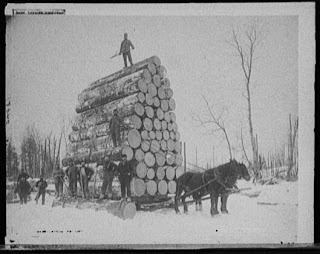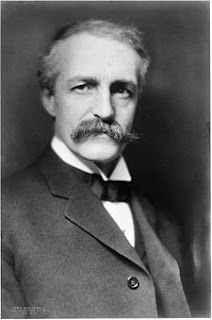The Founding of the National Forest Service
The idea of a National Forest Service was conceived by a man named Gifford Pinchot who went on to become the Chief of The U.S. Forest Service from 1905-1910. Pinchot was a close friend of President Theodore Roosevelt. He was quite wealthy having inherited a fortune from his father who inherited his fortune from his father. The grandfather became wealthy investing in land and cutting timber. Gifford Pinchot's father knew that much of the family's wealth came from deforestation and he regretted what it did to the land. As a result he encouraged the young Gifford to become involved with conservation.
Pinchot and Roosevelt
Being independently wealthy and having his brother handle his investments, Pinchot (photo to the left) was able to devote all of his time to conservation. The Yale graduate became nationally known through his work with Roosevelt in establishing the U.S. Forest Service. Prior to this time the government owned land was administered by the Department of Agriculture. Roosevelt who earlier in life had authored several books about the west had built a reputation for himself as being a hunter and outdoorsman and showed great interest in conserving the nations vast wilderness. Pinchot's vision struck the right chord with Roosevelt and the President was in the position to make things happen.
The National Forest Service and the Logging Industry
Roosevelt's administration was in existence during the latter part of the gilded age. Timber interests had heavy influence on Capitol Hill.
 As an example, U.S. Senators were chosen by state legislatures rather than by popular vote. The timber interests wanted no part of the government interfering with their deforestation. Pinchot, on the other hand, thought that there should be a joint effort between government and private industry to use the resources more wisely. He felt that logging could be managed in such a way to preserve the forests in the long term.
As an example, U.S. Senators were chosen by state legislatures rather than by popular vote. The timber interests wanted no part of the government interfering with their deforestation. Pinchot, on the other hand, thought that there should be a joint effort between government and private industry to use the resources more wisely. He felt that logging could be managed in such a way to preserve the forests in the long term.Both Roosevelt and Pinchot favored the smaller timber operations over the large conglomerates. He was witness to what unregulated cutting did to the eastern forests. Needless to say there was a lot of resistance from congress to appropriate funds for the service. When the Forest Service was established in 1905 it was run on a shoestring. Even so, the first forest rangers received extensive training from Gifford Pinchot himself often at his mansion called "Grey Towers". Pinchot was most influenced by Sir Dietrich Brandis who introduced the science of forestry to Britain. In fact he used many of Brandis' methods and structures when he established the Forest Service.
After Pinchot and others had much of the western forest land surveyed, much to the dislike of his political foes, Roosevelt finally signed it over to the Forest Service, taking it away from the Interior Department. In fact he signed over much more acreage than even his detractors thought he would.
Roosevelt, Pinchot and John Muir
 An interesting side note involves the conflicting viewpoints between Pinchot and John Muir.
An interesting side note involves the conflicting viewpoints between Pinchot and John Muir.Muir, being one of the country's foremost preservationists, founder of the Sierra Club and proponent of the 1898 National Parks Bill , wanted to see the wilderness unchanged period. Gifford Pinchot on the other hand wanted to wisely manage the nations natural resources for the benefit of the people and for future generations but he also recognized it's commercial value.
This difference of opinion certainly strained Muir's relationship with both Pinchot and Roosevelt who was also a friend of Muir's (photo of Roosevelt and Muir to the left). Muir however demonstrated his influence with Roosevelt convincing him to designate as National Protected Lands four separate areas including Yosemite.
Gifford Pinchot remained with the Forest Service until 1910 when then President Taft fired him during a controversy he had with the Secretary of the Interior. Pinchot as well as Roosevelt finally arrived at the opinion that Taft was the wrong man to further their conservation efforts. Many historians feel that Taft had very few visions of his own. Pinchot received several awards in his lifetime and entered politics where he served two separate terms of governor of Pennsylvania beginning in 1923. Gifford Pinchot was also one of the founders of the Yale School of Forestry in 1900.
The Forest Service and the Smokejumpers
 |
| Some of the first smokejumpers in 1948 |
The Forest Service has made a great deal of progress over the decades in the managing forests and in fighting forest and wildland fires. First of all, logging is closely controlled. Prescribed burns take place to prevent undergrowth buildup which can serve as fuel for fires started by lightening or any other cause.
The Forest Service has organized fire fighting crews at with various levels of experience. Smokejumpers are the most highly skilled since parachuting out of an airplane to fight fires is probably the most dangerous of jobs but is effective since it places firefighters in areas unreachable by land travel. A crew called Hotshots operate on the ground but are normally used at the hottest parts of the fire.
There are also crews designated to dig fire lines using the Pulaski Tool which was developed after the Great Fires of 1910. The Forest Service has come a long way and continues to study the fighting of forest and wildland fires. All of these efforts including the fighting of fire themselves are part of the overall conservation effort. The beginnings of this all started during the first decade of the 1900's due tio the efforts of both Pinchot and Roosevelt.
See our Western Trips article on the Pulaski Trail and the Pulaski fire fighting tool on the link below...
The Pulaski Tunnel Trail
There is much more to read about the conservation efforts of both Gifford Pinchot and Theodore Roosevelt. There were some critical events not in the least the Great Fire of !910. What is important to know is that the joint efforts of Roosevelt and Pinchot were a major influence in how the government, industry and the general public perceived national forest lands. Another very interesting stop while in Montana is Pompeys Pillar where the modern tourist can view the etched signature of William Clark of the Lewis and Clark Expedition. It is located near Billings Montana.
The National Museum of Forest Service History in Missoula Montana is an excellent source of information about the Forest Service. Not only will you find archives relating to the founding of the Forest Service but you will also learn how the Service helped with conservation programs throughout the decades and to the present day. While there is plenty to see right now, a new 30,000 sq. foot structure is set to open during the summer of 2011 located about one mile east of the Missoula International Airport. The museum address is 1615 South Catlin St., Missoula. The websites below will give you further information and keep you updated on the progress of the new building.
The site below offers additional information regarding Gifford Pinchot:
www.foresthistory.org
(Article copyright Western Trips. Photos and images from the public domain)


